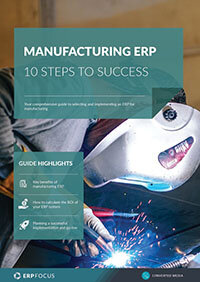Three CRM features to look for in your next manufacturing ERP
Many of today’s ERP systems include CRM (Customer Relationship Management) as an optional module or part of the basic package. CRM can be a very useful tool in any manufacturer’s ERP.
Integrated Analytics
CRM for manufacturing ERP systems will track contacts with customers and prospects. But it can go far beyond. CRM can be linked to economic and social databases as well. By combining customer feedback and other internal data with external data, there is tremendous power to make sense of chaos and improve decision making.
Recommended reading: learn how to make the most of all your manufacturing ERP’s modules with our ten steps to manufacturing ERP success
As an example, your number one product line has had feedback that it is a little hard to use but customers still got the value they wanted. Now your integrated analytics is picking up increased hiring at one of your competitors and rumors that someone else is about to introduce a rival product. That rival product might have a modern computer interface and be easier to use and it might be faster too. You “see and hear” information by combining hiring data, a couple of academic papers and a hint from at least one competitor at a trade show. Is this cause for alarm? It would get most businesses thinking of a response.
Linked documents and files
Customer feedback within a CRM can be very rich. Some will simply check boxes on a survey. Surprisingly, however, many will go beyond and offer real insights and suggestions for improvements. Some will attach documents such as a sketch of their idea or a link to knowledge from a trade show.
Your more sophisticated customers will want you to help with development of their upcoming products and your CRM will be the communication link directly to your ERP system. Yet another possible use for manufacturers is to use the CRM to send hints of future improvements to your ERP to keep their buying interest piqued. The attachments might be a screenshot displaying the improved interface. It could also be a link to a site where they can try it for size. Think about how you might use these capabilities in your manufacturing environment.
Email tracking
You are using your CRM for important communications and you want to protect and secure that information. The CRM in your ERP system should have those tools too. Track outbound email and other conversations. You can see whether the other person opened your communications at all and how often they opened it. You can also see when they forwarded the communication and, again, how many times it was opened. This helps build contacts in your CRM database. The number of times a document is opened and how long it was opened all are indicators of interest. Be sure you keep your product development in line with actual customer and prospect measured interest. If your contacts do not indicate interest, consider other channels of communication or better media. Don’t waste effort sending out data that misses the target.
Good story, right friends? Who knew CRM for manufacturing ERPs could be so useful? Let’s take another look at that CRM menu.
Free white paper

Manufacturing ERP: 10 steps to success
Complete step-by-step guide to manufacturing ERP software

Related articles
-

Three challenges to overcome when integrating ERP with CRM
It’s easy to slip whilst integrating your ERP and CRM software - here are areas where you shouldt...
-

CMMC Compliance: What Aerospace and Defense Manufacturers Need to Know
Key insights on CMMC compliance, deadlines, and securing DoD contracts with CMMC 2.0 certificatio...
-

Using your ERP to ensure quality control in your food manufacturing process
How your ERP can be used to ensure quality and compliance for your food manufacturing business

